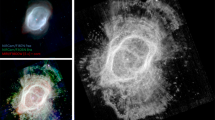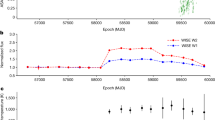Abstract
Stellar occultations—the passing of a relatively nearby body in front of a background star—can be used to probe the atmosphere of the closer body with a spatial resolution of a few kilometres (ref. 1). Such observations can yield the scale height, temperature profile, and other information about the structure of the occulting atmosphere. Occultation data acquired for Pluto's atmosphere in 1988 revealed a nearly isothermal atmosphere2 above a radius of ∼1,215 km. Below this level, the data could be interpreted as indicating either an extinction layer or the onset of a large thermal gradient, calling into question the fundamental structure of this atmosphere. Another question is to what extent Pluto's atmosphere might be collapsing as it recedes from the Sun (passing perihelion in 1989 in its 248-year orbital period), owing to the extreme sensitivity of the equilibrium surface pressure to the surface temperature. Here we report observations at a variety of visible and infrared wavelengths of an occultation of a star by Pluto in August 2002. These data reveal evidence for extinction in Pluto's atmosphere and show that it has indeed changed, having expanded rather than collapsed, since 1988.
This is a preview of subscription content, access via your institution
Access options
Subscribe to this journal
Receive 51 print issues and online access
$199.00 per year
only $3.90 per issue
Buy this article
- Purchase on Springer Link
- Instant access to full article PDF
Prices may be subject to local taxes which are calculated during checkout




Similar content being viewed by others
References
Elliot, J. L. & Olkin, C. B. Probing planetary atmospheres with stellar occultations. Annu. Rev. Earth Planet. Sci. 24, 89–123 (1996)
Elliot, J. L. & Young, L. A. Analysis of stellar occultation data for planetary atmospheres. I. Model fitting, with application to Pluto. Astron. J. 103, 991–1015 (1992)
Brown, G. N. Jr & Ziegler, W. T. Vapor pressure and heats of vaporization and sublimation of liquids and solids of interest in cryogenics below 1-atm pressure. Adv. Cryog. Eng. 25, 662–670 (1980)
Hubbard, W. B., Hunten, D. M., Dieters, S. W., Hill, K. M. & Watson, R. D. Occultation evidence for an atmosphere on Pluto. Nature 336, 452–454 (1988)
Elliot, J. L. et al. Pluto's atmosphere. Icarus 77, 148–170 (1989)
Millis, R. L. et al. Pluto's radius and atmosphere: Results from the entire 9 June 1988 occultation data set. Icarus 105, 282–297 (1993)
Eshleman, V. R. Pluto's atmosphere: Models based on refraction, inversion, and vapor-pressure equilibrium. Icarus 80, 439–443 (1989)
Hubbard, W. B., Yelle, R. V. & Lunine, J. I. Nonisothermal Pluto atmosphere models. Icarus 84, 1–11 (1990)
McDonald, S. W. & Elliot, J. L. Pluto-Charon stellar occultation candidates: 1996-1999. Astron. J. 112, 788–796 (1996)
McDonald, S. W. & Elliot, J. L. Pluto-Charon stellar occultation candidates: 2000-2009 Astron. J. 119, 1999 (2000), Erratum 120, 1599–1602 (2000)
Buie, M. W. et al. Changes in Pluto's atmosphere revealed by the P126A occultation. Bull. Am. Astron. Soc. 34, 877 (2002)
Sicardy, B. et al. Large changes in Pluto's atmosphere as revealed by recent stellar occultations. Nature 424, 168–170 (2003)
Rayner, J. T. et al. SpeX: A medium-resolution 0.8-5.4 micron spectrograph and imager for the NASA Infrared Telescope Facility. Publ. Astron. Soc. Pacif. 115, 362–382 (2003)
Vacca, W. D., Cushing, M. C. & Rayner, J. T. A method for correcting near-infrared spectra for telluric absorption. Publ. Astron. Soc. Pacif. 115, 389–409 (2003)
van de Hulst, H. C. Light Scattering by Small Particles (Dover, New York, 1981)
Summers, M. E., Strobel, D. F. & Gladstone, G. R. in Pluto and Charon (eds Stern, S. A. & Tholen, D. J.) 391–434 (Univ. Arizona Press, Tucson, 1997)
Elliot, J. L., Person, M. J. & Qu, S. Analysis of stellar occultation data. II. Inversion, with application to Pluto and Triton. Astron. J. (in the press)
Olkin, C. B., Wasserman, L. H. & Franz, O. G. The mass ratio of Charon to Pluto from Hubble Space Telescope astrometry with Fine Guidance Sensors. Icarus (in the press)
Elliot, J. L. et al. Global warming on Triton. Nature 393, 765–767 (1998)
Elliot, J. L. et al. The prediction and observation of the 1997 July 18 stellar occultation by Triton: More evidence for distortion and increasing pressure in Triton's atmosphere. Icarus 148, 347–369 (2000)
Fröhlich, C. Total solar irradiance variations since 1978. Adv. Space Res. 29, 1409–1416 (2002)
Hansen, C. J. & Paige, D. A. Seasonal nitrogen cycles on Pluto. Icarus 120, 247–265 (1996)
Buie, M. W. et al. CCD camera occultation system. Bull. Am. Astron. Soc. 25, 1115 (1993)
Dunham, E. W. in Proc. Airborne Astronomy Symp. on the Galactic Ecosystem: From Gas to Stars to Dust (eds Haas, M. R., Davidson, J. A. & Erickson, E. F.) 517–522 (Astronomical Society of the Pacific, San Francisco, 1995)
Puxley, P. J. et al. Performance of an SBRC 256 × 256 array with ALICE/IRCAM3. Proc. SPIE 2198, 350–358 (1994)
Khare, B. N. et al. Optical constants of organic tholins produced in a simulated Titanian atmosphere: From soft X-ray to microwave frequencies. Icarus 60, 127–137 (1984)
Thomas-Osip, J. E., Elliot, J. L. & Clancy, K. B. Re-examination of the possibility of haze in Pluto's atmosphere based on multi-wavelength observations of the Pluto occultation of P131.1. Bull. Am. Astron. Soc. 34, 1212 (2002)
Stansberry, J. A., Lunine, J. I. & Tomasko, M. G. Upper limits on possible photochemical hazes on Pluto. Geophys. Res. Lett. 16, 1221–1224 (1989)
Rannou, P., McKay, C. P., Botet, R. & Cabane, M. Semi-empirical model of absorption and scattering by isotropic fractal aggregates of spheres. Planet. Space Sci. 47, 385–396 (1999)
Rannou, P. et al. Titan's geometric albedo: Role of the fractal structure of the aerosols. Icarus 118, 355–372 (1995)
Acknowledgements
Setting up the equipment and recording the occultation data proved to be a challenge, and we appreciate the assistance of G. Koenig, L. Berkgnut, T. Denault, P. Sears, R. Stone, D. Severinsen, A. Pickles and T. Carroll. We thank the staff of the Maui Space Surveillance System for their assistance in taking the Haleakala data, and we thank B. Sicardy et al. for communication of results before publication. The United Kingdom Infrared Telescope is operated by the Joint Astronomy Centre on behalf of the UK Particle Physics and Astronomy Research Council. This work was supported, in part, by Research Corporation, the Southwest Research Institute, NSF and NASA. L.C.R. and D.T.H. were supported by Air Force Research Laboratory/Directed Energy.
Author information
Authors and Affiliations
Corresponding author
Ethics declarations
Competing interests
The authors declare that they have no competing financial interests.
Supplementary information
Rights and permissions
About this article
Cite this article
Elliot, J., Ates, A., Babcock, B. et al. The recent expansion of Pluto's atmosphere. Nature 424, 165–168 (2003). https://doi.org/10.1038/nature01762
Received:
Accepted:
Issue Date:
DOI: https://doi.org/10.1038/nature01762
This article is cited by
-
Nitrogen Atmospheres of the Icy Bodies in the Solar System
Space Science Reviews (2020)
-
The Pluto system after the New Horizons flyby
Nature Astronomy (2017)
-
Planetary science: The Pluto siblings
Nature (2015)
-
Exploration of the Outer Solar System by Stellar Occultations
Earth, Moon, and Planets (2009)
-
The New Horizons Radio Science Experiment (REX)
Space Science Reviews (2008)
Comments
By submitting a comment you agree to abide by our Terms and Community Guidelines. If you find something abusive or that does not comply with our terms or guidelines please flag it as inappropriate.



